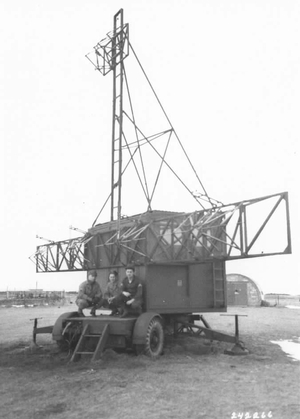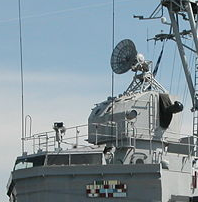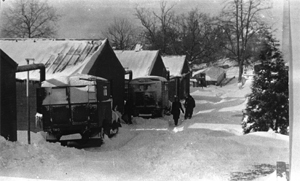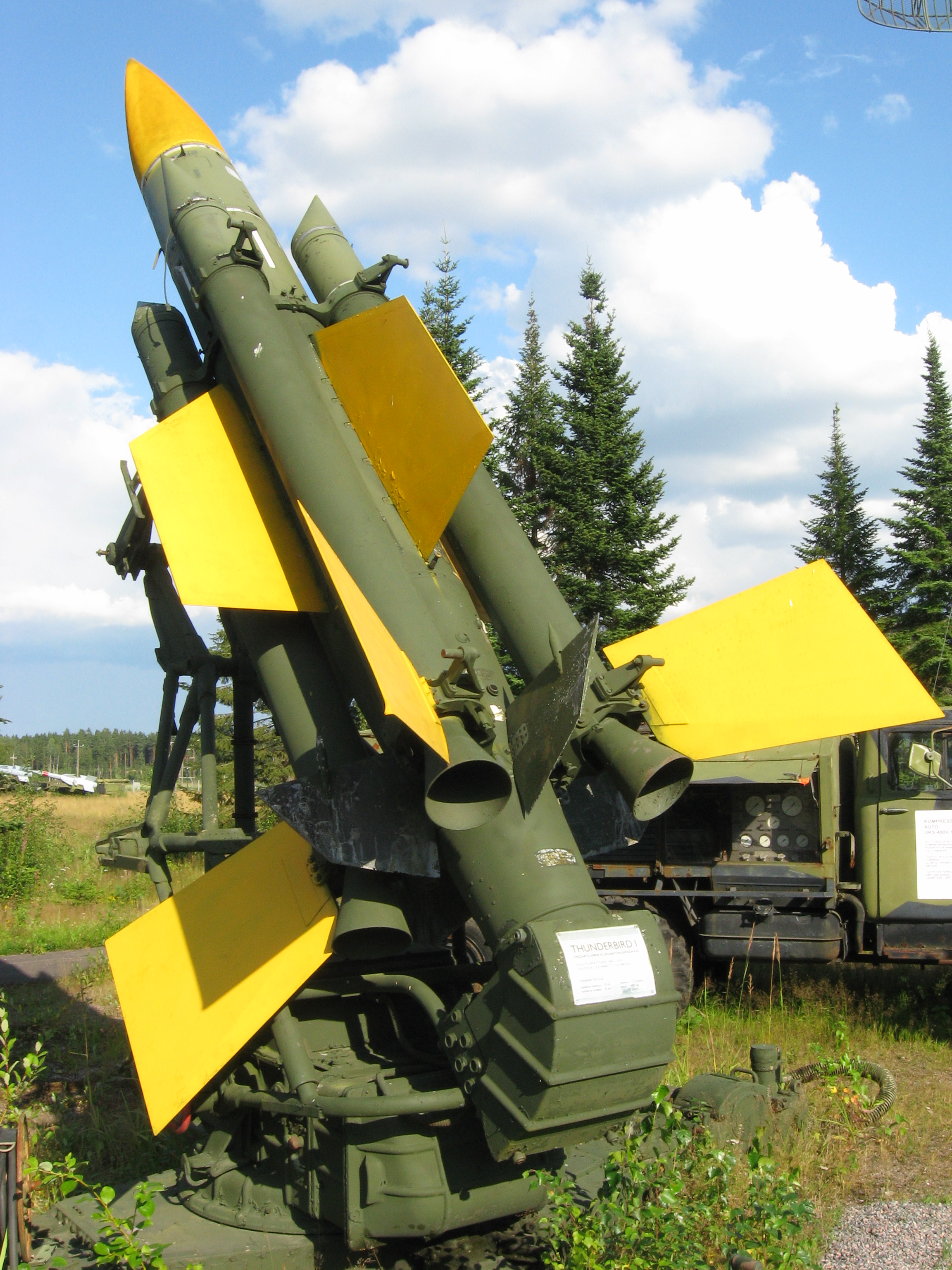|
AA No. 3 Mark 7
Radar, Anti-Aircraft Number 3 Mark 7, also widely referred to by its development rainbow code Blue Cedar, was a mobile anti-aircraft gun laying radar designed by British Thomson-Houston (BTH) in the mid-1940s. It was used extensively by the British Army and was exported to countries such as Holland, Switzerland, Sweden Finland and South Africa. In British service, it was used with the 5.25 inch and QF 3.7 inch AA guns, as well as the Brakemine missile. Mk. 7 developed from experiments in the mid-WWII era on auto-follow radar systems on the GL Mk. III radar and Searchlight Control radar systems. Production was not taken up at that time due to the imminent arrival of the SCR-584. The concept was studied again in the immediate post-war era, further improvements made, and put into production starting in 1952. About 365 were made in three major production runs, the last ordered in 1954. The unit was housed in an air-conditioned trailer that was significantly smaller and more port ... [...More Info...] [...Related Items...] OR: [Wikipedia] [Google] [Baidu] |
Counter-battery Radar
A counter-battery radar (alternatively weapon tracking radar or COBRA) is a radar system that detects artillery projectiles fired by one or more guns, howitzers, mortars or rocket launchers and, from their trajectories, locates the position on the ground of the weapon that fired it. Such radars are a subclass of the wider class of target acquisition radars. Early counter-battery radars were generally used against mortars, whose lofted trajectories were highly symmetrical and allowed easy calculation of the launcher's location. Starting in the 1970s, digital computers with improved calculation capabilities allowed more complex trajectories of long-range artillery to also be determined. Normally, these radars would be attached to friendly artillery units or their support units, allowing them to quickly arrange counter-battery fire. With the aid of modern communications systems, the information from a single radar can be rapidly disseminated over long distances. This allows the ra ... [...More Info...] [...Related Items...] OR: [Wikipedia] [Google] [Baidu] |
Director (military)
A director, also called an auxiliary predictor, is a mechanical or electronic computer that continuously calculates trigonometric firing solutions for use against a moving target, and transmits targeting data to direct the weapon firing crew. Naval warships For warships of the 20th century, the director is part of the fire control system; it passes information to the computer that calculates range and elevation for the guns. Typically, positions on the ship measured range and bearing of the target; these instantaneous measurements are used to calculate rate of change values, and the computer ("fire control table" in Royal Navy terms) then predicts the correct firing solution, taking into account other parameters, such as wind direction, air temperature, and ballistic factors for the guns. The British Royal Navy widely deployed the Pollen and Dreyer Fire Control Tables during the First World War, while in World War II a widely used computer in the US Navy was the electro-mechanical ... [...More Info...] [...Related Items...] OR: [Wikipedia] [Google] [Baidu] |
Soft Sutton Tube
A Sutton tube, or reflex klystron, is a type of vacuum tube used to generate microwaves. It is a low-power device used primarily for two purposes; one is to provide a tuneable low-power frequency source for the local oscillators in receiver circuits, and the other, with minor modifications, as a switch that could turn on and off another microwave source. The second use, sometimes known as a soft Sutton tube or rhumbatron switch, was a key component in the development of microwave radar by Britain during World War II. Microwave switches of all designs, including these, are more generally known as T/R tubes or T/R cells. The Sutton tube is named for one of its inventors, Robert Sutton, an expert in vacuum tube design. The original klystron designs had been developed in the late 1930s in the US, and Sutton was asked to develop a tuneable version. He developed the first models in late 1940 while working at the Admiralty Signals and Radar Establishment. Sutton tubes were widely used in a ... [...More Info...] [...Related Items...] OR: [Wikipedia] [Google] [Baidu] |
Telecommunications Research Establishment
The Telecommunications Research Establishment (TRE) was the main United Kingdom research and development organization for radio navigation, radar, infra-red detection for heat seeking missiles, and related work for the Royal Air Force (RAF) during World War II and the years that followed. It was regarded as "the most brilliant and successful of the English wartime research establishments" under "Rowe, who saw more of the English scientific choices between 1935 and 1945 than any single man." The name was changed to Radar Research Establishment in 1953, and again to the Royal Radar Establishment in 1957. This article covers the precursor organizations and the Telecommunications Research Establishment up to the time of the name change. The later work at the site is described in the separate article about RRE. History TRE is best known for work on defensive and offensive radar. TRE also made substantial contributions to radio-navigation and to jamming enemy radio-navigation. Rad ... [...More Info...] [...Related Items...] OR: [Wikipedia] [Google] [Baidu] |
Air Ministry
The Air Ministry was a department of the Government of the United Kingdom with the responsibility of managing the affairs of the Royal Air Force, that existed from 1918 to 1964. It was under the political authority of the Secretary of State for Air. Organisations before the Air Ministry The Air Committee On 13 April 1912, less than two weeks after the creation of the Royal Flying Corps (which initially consisted of both a naval and a military wing), an Air Committee was established to act as an intermediary between the Admiralty and the War Office in matters relating to aviation. The new Air Committee was composed of representatives of the two war ministries, and although it could make recommendations, it lacked executive authority. The recommendations of the Air Committee had to be ratified by the Admiralty Board and the Imperial General Staff and, in consequence, the Committee was not particularly effective. The increasing separation of army and naval aviation from 191 ... [...More Info...] [...Related Items...] OR: [Wikipedia] [Google] [Baidu] |
Cathode Ray Tube
A cathode-ray tube (CRT) is a vacuum tube containing one or more electron guns, which emit electron beams that are manipulated to display images on a phosphorescent screen. The images may represent electrical waveforms ( oscilloscope), pictures (television set, computer monitor), radar targets, or other phenomena. A CRT on a television set is commonly called a picture tube. CRTs have also been used as memory devices, in which case the screen is not intended to be visible to an observer. The term ''cathode ray'' was used to describe electron beams when they were first discovered, before it was understood that what was emitted from the cathode was a beam of electrons. In CRT television sets and computer monitors, the entire front area of the tube is scanned repeatedly and systematically in a fixed pattern called a raster. In color devices, an image is produced by controlling the intensity of each of three electron beams, one for each additive primary color (red, green, and bl ... [...More Info...] [...Related Items...] OR: [Wikipedia] [Google] [Baidu] |
Parabolic Reflector
A parabolic (or paraboloid or paraboloidal) reflector (or dish or mirror) is a reflective surface used to collect or project energy such as light, sound, or radio waves. Its shape is part of a circular paraboloid, that is, the surface generated by a parabola revolving around its axis. The parabolic reflector transforms an incoming plane wave travelling along the axis into a spherical wave converging toward the focus. Conversely, a spherical wave generated by a point source placed in the focus is reflected into a plane wave propagating as a collimated beam along the axis. Parabolic reflectors are used to collect energy from a distant source (for example sound waves or incoming star light). Since the principles of reflection are reversible, parabolic reflectors can also be used to collimate radiation from an isotropic source into a parallel beam. In optics, parabolic mirrors are used to gather light in reflecting telescopes and solar furnaces, and project a beam of light in flas ... [...More Info...] [...Related Items...] OR: [Wikipedia] [Google] [Baidu] |
Kilowatts
The watt (symbol: W) is the unit of power or radiant flux in the International System of Units (SI), equal to 1 joule per second or 1 kg⋅m2⋅s−3. It is used to quantify the rate of energy transfer. The watt is named after James Watt (1736–1819), an 18th-century Scottish inventor, mechanical engineer, and chemist who improved the Newcomen engine with his own steam engine in 1776. Watt's invention was fundamental for the Industrial Revolution. Overview When an object's velocity is held constant at one metre per second against a constant opposing force of one newton, the rate at which Work (physics), work is done is one watt. : \mathrm In terms of electromagnetism, one watt is the rate at which electrical work is performed when a current of one ampere (A) flows across an electrical potential difference of one volt (V), meaning the watt is equivalent to the volt-ampere (the latter unit, however, is used for a different quantity from the real power of an electric ... [...More Info...] [...Related Items...] OR: [Wikipedia] [Google] [Baidu] |
Cavity Magnetron
The cavity magnetron is a high-power vacuum tube used in early radar systems and currently in microwave ovens and linear particle accelerators. It generates microwaves using the interaction of a stream of electrons with a magnetic field while moving past a series of cavity resonators, which are small, open cavities in a metal block. Electrons pass by the cavities and cause microwaves to oscillate within, similar to the functioning of a whistle producing a tone when excited by an air stream blown past its opening. The resonant frequency of the arrangement is determined by the cavities' physical dimensions. Unlike other vacuum tubes, such as a klystron or a traveling-wave tube (TWT), the magnetron cannot function as an amplifier for increasing the intensity of an applied microwave signal; the magnetron serves solely as an oscillator, generating a microwave signal from direct current electricity supplied to the vacuum tube. The use of magnetic fields as a means to control the f ... [...More Info...] [...Related Items...] OR: [Wikipedia] [Google] [Baidu] |
Weather Balloon
A weather balloon, also known as sounding balloon, is a balloon (specifically a type of high-altitude balloon) that carries instruments aloft to send back information on atmospheric pressure, temperature, humidity and wind speed by means of a small, expendable measuring device called a radiosonde. To obtain wind data, they can be tracked by radar, radio direction finding, or navigation systems (such as the satellite-based Global Positioning System, GPS). Balloons meant to stay at a constant altitude for long periods of time are known as ''transosondes''. Weather balloons that do not carry an instrument pack are used to determine upper-level winds and the height of cloud layers. For such balloons, a theodolite or total station is used to track the balloon's azimuth and elevation, which are then converted to estimated wind speed and direction and/or cloud height, as applicable. Weather balloons are launched around the world for observations used to diagnose current conditions ... [...More Info...] [...Related Items...] OR: [Wikipedia] [Google] [Baidu] |
Thunderbird (missile)
The English Electric Thunderbird was a British surface-to-air missile produced for the British Army. Thunderbird was primarily intended to attack higher altitude targets at ranges up to approximately , providing wide-area air defence for the Army in the field. AA guns were still used for lower altitude threats. Thunderbird entered service in 1959 and underwent a major mid-life upgrade to Thunderbird 2 in 1966, before being slowly phased out by 1977. Ex-Army Thunderbirds were also operated by the Royal Saudi Air Force after 1967. Thunderbird had performance similar to other semi-portable missiles like the US MIM-23 Hawk and fully mobile Soviet 2K11 Krug, although it pre-dates both of these systems. After its mid-life upgrades, which shared several components with the RAF's Bristol Bloodhound, Thunderbird featured a continuous-wave radar semi-active homing system that was highly resistant to radar jamming and deception, and was able to track targets even at very low altitudes. Th ... [...More Info...] [...Related Items...] OR: [Wikipedia] [Google] [Baidu] |
British Army Of The Rhine
There have been two formations named British Army of the Rhine (BAOR). Both were originally occupation forces in Germany, one after the First World War and the other after the Second World War. Both formations had areas of responsibility located around the German section of the River Rhine. History 1919–1929 The first British Army of the Rhine was set up in March 1919 to implement the occupation of the Rhineland. It was originally composed of five corps, composed of two divisions each, plus a cavalry division: II Corps: Commanded by Sir Claud Jacob :* Light Division (formed from 2nd Division): Commanded by Major-General George Jeffreys :* Southern Division (formed from 29th Division): Commanded by Major-General William Heneker IV Corps: Commanded by Sir Alexander Godley :* Lowland Division (formed from 9th Division) :* Highland Division (formed from 62nd Division) VI Corps: Commanded by Sir Aylmer Haldane :* Northern Division (formed from 3rd Division) :* London Di ... [...More Info...] [...Related Items...] OR: [Wikipedia] [Google] [Baidu] |









